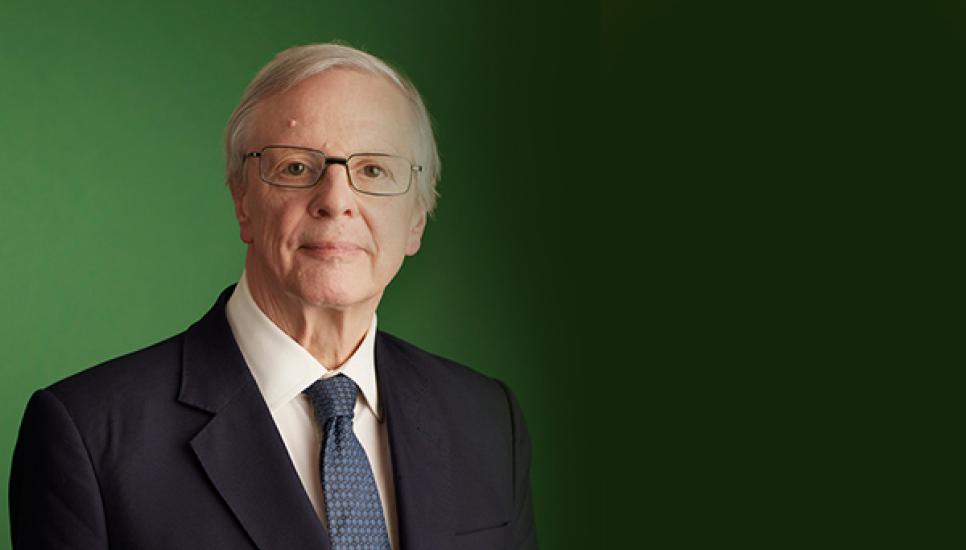Jonathan Ruffer's Investment Review

One early afternoon in September, some of us gathered on the balcony of the Ruffer offices, and looked across at Buckingham Palace, not two hundred yards away, as her late Majesty, Queen Elizabeth, began her last journey from Palace to Westminster Abbey. The plane trees in the Mall obscured the view, but the sound of the catafalque, the solemn music hanging in the air, the interjections of military command all emphasised the immediacy of the passing of an old order. Not since Queen Victoria’s death has Britain experienced a single event which captured the shift of tectonic plates which had seemed permanently – or was it only momentarily? – fixed rigid.
Moods are created by events, for sure – but events are created by moods, too. Kipling’s verse balances the permanence and evanescence of greatness – it was written at the time of Queen Victoria’s Diamond Jubilee, when tout le monde gathered to celebrate:
The tumult and the shouting dies;
The Captains and the Kings depart:
Lord God of Hosts, be with us yet,
Lest we forget – lest we forget!
Lo, all our pomp of yesterday
Is one with Nineveh and Tyre!
Judge of the Nations, spare us yet,
Lest we forget - lest we forget!
Rudyard Kipling died on 18 January, 1936. His death was the first of three which occurred in the same week, and marked, to my mind, a formal eclipse of that old order. George V, King of England, Emperor of India, died on 20 January. Three days later the voice of Empire, Dame Clara Butt, whose powerful contralto (une voix obscène, opined Reynaldo Hahn) had boomed out Land of Hope and Glory, dominating the massed voices of the crowds gathered for Empire Day each year in Hyde Park.
Humanity has a tendency to believe that a settled pattern of order will continue indefinitely.
What has this to do with investment? Humanity has a tendency to believe that a settled pattern of order will continue indefinitely. That’s where we are now – the world of investment has been in a unidirectional bull market for forty years – since 10 August 1982. Kipling wrote the words quoted above in 1897, but not until his death, and those of the other representatives of that old order, did the inherent dangers of the reordering of the tectonic plates become relevantly apparent.
Economists are not the greatest readers of events, but one of them, Hyman Minsky, was prophetic, and like many pukka prophets, he was hardly known in his lifetime. His great insight was that the dislocations which follow a long period of stability are greater than those which occur in uncertain times. It may have been Minsky or one of his followers who used the image of an hourglass, where the sand forms a triangular mound in its lower half, as it passes from top to bottom; the sand, being unstable, regularly causes small avalanches which flatten its landscape; if, however, the chance configuration of the sand allows the mound to become taller, bigger, then the moment of its destruction is more dislocative. The Minsky moment is a Rudyard Kipling moment – you can point to both a confidence in the stability of things around a society, and know, at the same time, it does not end happily.
There are two arguments for this to be relevant today. The first is the extreme levels of debt which have been created over decades, leading to a modus operandi throughout the investment and commercial world which depends on its further creation, and at low rates of interest. The second is to beware the evil eye which accompanies sustained success.
In the forty-five years I have been an investor, I cannot recall a more dangerous period than today.
In the forty-five years I have been an investor, I cannot recall a more dangerous period than today. It sometimes happens that markets are about to fall sharply, and we are no stranger to navigating them – my first as a stand-alone fund manager was in 1987. But each of these falls, so far, has been partial, in that there were asset-classes which did not participate in the decline, or – as has more recently been the case – there have been insurances which had been overlooked or disdained, and offered a good risk/reward. In 1987, for instance, the real-yield on index-linked stocks approached 5% – it was hard, really, to own anything else; today, those yields are negative, meaning that you are bound to lose money in them (in real terms) if you hold them to maturity.
This chronic sense that investments are dangerous is now accompanied by an acute sense of specific danger to the markets – the rumblings of a liquidity crisis, perhaps the first in a series in the years ahead. What is liquidity? When money’s a-plenty, the question to ask is: ‘do I want to buy it?’ When there’s no money, then the question is more fundamental: ‘can I buy it?’ Dr Johnson, not admittedly one of nature’s economic smartboys, captured it well, visiting the Western Isles, and noticing that eggs changed hands for a ha’penny, whereas, on the mainland, they cost a penny. Johnson turned to his scribe and said, “They are not cheap because there is a surfeit of eggs, but because there is a dearth of ha’pence.” We have lived, certainly since Alan Greenspan in the 1980s, in a world where any shortage of ha’pennies has been met with a cascade of half-crowns from the central banks – aided and abetted by the commercial banks who have been able to mint brand new coinage through wind, through weather. What we have come to take for granted cannot necessarily be relied upon in a world where there is a concerted effort to control the amount of money available.
When there’s no money in the system, and the channels of its creation are blocked, many fine investments, which, in normal circumstances would be mouth-watering to own, are unsellable. If, at that point, you need money, and all you have are assets – watch out!
We are watching out. Over the last generation, there have been several liquidity crises, but central banks (the Federal Reserve, in practice) have always created the necessary money. This is not magic – banks, both commercial and central, create money routinely – the granting of a loan by either one of them is itself a creative act: it is, in accounting terms, merely the creation of a liability, matching the loan to a customer/counterparty, which is a corresponding asset in its books.
We see pressures building, pressures that encourage a liquidation of risky assets, and a degradation in the liquidity conditions of markets.
At Ruffer we see pressures building, pressures that encourage a liquidation of risky assets, and a degradation in the liquidity conditions of markets. The simplicity of the following explanation, centred on the United States, will be unattractive for two opposite reasons. To the technician, it will be a Thomas the Tank Engine survey of deeply complex and technical questions. To most human beings, it will bring about Winston Churchill’s exasperated observation when Chancellor of the Exchequer, “When bankers get together, why do they always speak in Persian?”
The Federal Reserve is the ultimate source of money-creation. It has expanded its supply of money to the point where its credibility is coming into question, and so must contract it. But the Fed needs to tread carefully, and indeed it is being careful, notwithstanding its need to rein in that money because of inflationary pressures. (Central to our continuing belief that inflation is the end-game is the central bankers’ extreme reluctance to be harsh with the economy; our views are not changed by Jerome Powell’s recent belligerence – it’s one thing to sound fierce about raising interest rates when they are 3%, but quite another to do it at 20% in the midst of a recession, as his distinguished predecessor Paul Volcker did.) As well as battling to keep the quantity of money in check, the Fed is simultaneously straining to make sure the transmission of its interest rates to the real economy is working. As interest rates go up, savers expect to see that paid to them – but the commercial banks aren’t passing it on. One of the big savings vehicles in the US are Money-Market Funds – roughly 90% of which only invest in government quality instruments. There aren’t enough of these bonds, so the Fed is providing interest at its desired level to these funds, and now has tied up $2.36 trillion of money-market cash, in this service to the community. The key is that, unlike regular bank deposits, this $2.36 trillion cannot be injected into the US financial system if it’s needed. The Fed’s inflation-busting rhetoric means too, that it is shrinking its balance sheet. Commercial banks can, in theory, create money as easily and effectively as the Fed, except they, too, had whoopsies in 2008, and are now so regulated that they can’t create money in necessary size either. Indeed, their commercial imperative is to keep existing businesses supplied with liquidity, at a time when inflation is driving up the latter’s cash requirements – and, anyhow, the commercial banks make good margins on these loans, so why not divert more of their balance sheets to these activities, and away from lower-margin financial market funding activities?
We see danger ahead. Markets are still too high, and protection is expensive in an increasingly nervous world; common sense suggests one should invest conservatively, and in safe assets. In a world where people find themselves without the ability to pay commitments as they arise, forced selling drives prices. Among risky assets like equities, one of the counter-intuitive things in a liquidity crisis is that securities perceived as safest and most liquid go down sharply, because investors are forced to sell what they can, not what they want to. We therefore regard plentiful liquidity in the portfolio as overwhelmingly attractive; it allows us to make the most of the opportunities that arise in the aftermath of a crisis. But first we have to get through the storm.
The views expressed in this article are not intended as an offer or solicitation for the purchase or sale of any investment or financial instrument, including interests in any of Ruffer’s funds. The information contained in the article is fact based and does not constitute investment research, investment advice or a personal recommendation, and should not be used as the basis for any investment decision. References to specific securities are included for the purposes of illustration only and should not be construed as a recommendation to buy or sell these securities. This document does not take account of any potential investor’s investment objectives, particular needs or financial situation. This document reflects Ruffer’s opinions at the date of publication only, the opinions are subject to change without notice and Ruffer shall bear no responsibility for the opinions offered. Read the full disclaimer.
This financial promotion issued by Ruffer LLP, which is authorised and regulated by the Financial Conduct Authority in the UK and is registered as an investment adviser with the US Securities and Exchange Commission (SEC). Registration with the SEC does not imply a certain level of skill or training. © Ruffer LLP 2022. 80 Victoria Street, London SW1E 5JL ruffer.co.uk






